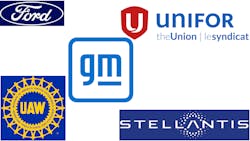So That Happened: Organized Labor Having Its Moment and Cows Embrace Robotics
Editor’s note: Welcome to So That Happened, our editors’ takes on things going on in the manufacturing world that deserve some extra attention. This will appear regularly in the Member’s Only section of the site.
Forget the Oscars. Union Negotiations Are the Best Show in Town
Last year was particularly prolific for union organizing efforts, with the number of union elections in the U.S. nearly doubling from 2021 and the number of successful union elections rising from 61% to 72%, according to the National Labor Relations Board. UAW workers at John Deere and agriculture and construction machinery manufacturer CNH won higher wages, better benefits and bigger signing bonuses; and of course, Amazon and Starbucks workers fought high-profile battles with mixed success.
So, the momentum is building for UAW negotiations in September with the Detroit 3 automakers—Ford, General Motors and Stellantis. What’s more, U.S. and Canadian autoworkers will be bargaining concurrently for the first time since 1989. The Canadian union brings more public support to the table: 18% of private-sector workers in Ontario are unionized, compared with about 6% of private-sector workers in the U.S.
At the Automotive Symposium at the Detroit Branch of Chicago Federal Reserve earlier this month, Lana Payne, president of Unifor, the UAW’s Canadian counterpart, shared her take on the coming negotiations. “Without a doubt, you’ll be hearing a lot about jobs, about job quality, about income security and the EV transition over the coming months,” she said, calling the September talks “a way station on the path to electrification.”
Payne noted that one-third of current UAW jobs are not compatible with electrification, and remarked that while many workers were retrained when General Motors converted its Oakville, Ontario, plant to make BrightDrop electric shuttles, 750 Unifor members working in the supply base around the plant lost their jobs for good in the shift. “There’s an undeniable anxiety that afflicts workers during these periods,” she said. She later added, “It’s important that we do not disregard the challenges that transition brings.”
The job of union leadership in 2023, she said, is to “ensure our collective agreements are equipped to support workers through this transition period, from workforce retention to income security and to skills readiness. And yes, despite economic storm clouds looming, largely manufactured by central bankers, I might add, we’ll be bargaining against the backdrop of a very tight labor market with a high demand for skills. This puts workers very much in the driver's seat. My team and I are really looking to get underway.
“The auto sector is at a certain inflection point right now. The decisions made today on matters of product allocation, consumer adoption, and skills will define what success looks like from decades from now. How we define job quality, and promote collective bargaining as a social good, will in turn present our vision for what a truly just transition can and should be. We have to get this right.”
Isn’t Security an Important Process?
Aptean, a software development company that aims its services at manufacturers and distributors, on Monday released a new report, “Industry Insights from Industrial and Process Manufacturers.” As with all reports it’s the questions raised or implied and not answered that make the report most interesting.
One of the data points within the section about digital evolution driving growth states that companies using the cloud saw higher annual revenue increases than companies sticking with software running on local networks. And this is where the report could have waved a hand at something: cybersecurity.
Any organization that moves to the cloud to access third-party software or just for data storage opens up a whole new set of attack surfaces for cybercriminals. We try to hit this point about third-party cybersecurity often at IndustryWeek.
Nissan's most recent breach was third-party related. Twitter recently saw data for millions of its users published on the web due to an API-based vulnerability. Whenever you give someone outside your company access to your data, you're assuming they are taking appropriate cybersecurity measures.
So, it would have been interesting to see how the industrial and process manufacturers that responded to the Aptean report approach cybersecurity plan to approach cybersecurity generally and for third-party vendors specifically in 2023.
Hopefully these manufacturers perform security audits, if they have the resources to do so, of any third-party vendor to whom they give access to their data. Nowadays it's just common sense. And I wouldn’t be surprised if someday we see third-party vendors taking more pains to advertise their cybersecurity regimens, not just mentioning this within the fine print but holding up a neon sign, as a benefit of doing business with them.
Losing Your Lunch or Losing an Army Contract?
Congress has rejected the U.S. Army’s bid to buy $400 million worth of virtual reality goggles from Microsoft, saying the technology is turning soldiers the wrong shade of green—nauseated instead of battle ready.
Rather than award Microsoft a massive contract for military adaptations to its HoloLens headsets, the Army will spend $40 million to develop a new version of the technology, preferably one that doesn’t sicken soldiers.
In October, several reports noted that more than 80% of soldiers testing VR headsets reported nausea, in many cases severe nausea—not ideal for an environment as chaotic as the battlefield.
The goal of the Microsoft Integrated Visual Augmentation System (IVAS) was to provide ground soldiers the same data-rich environment that fighter pilots enjoy with head up displays. For now, however, it’s back to the drawing board as Microsoft and the Army figure out how to deliver that data to people running across uneven terrain while loaded down with gear.
40 Years, 30 Million Automobiles
Since production of the Honda Accord began at their Marysville Auto Plant in Ohio in November 1982, Honda has hit an impressive milestone of 30 million vehicle production in the U.S. The accomplishment was achieved through their eight U.S. auto manufacturing facilities in Alabama, Georgia, Indiana and Ohio.
With $16 billion invested in U.S. manufacturing operations, including over $3.2 billion in just the past five years, two-thirds of all Honda and Acura vehicles sold in the U.S. were made in America.
“Reaching this 30 million milestone is the direct result of our associates, past and present, who made this significant achievement possible,” said Bob Schwyn, senior vice president of Honda Development & Manufacturing of America, LLC. With an annual production capacity of 1.3 million vehicles, these eight facilities employ almost 17,000 associates.
In preparation for the future, the company has recently announced investments to create an “EV Hub” in Ohio. $700 million will re-tool three existing plants for EV production, while a $3.5 billion joint investment with LG Energy Solution will be to establish a joint venture facility to produce battery modules.
Embrace Automation Like a Cow!
It’s the stuff of dystopian science fiction. Autonomous robots using vision guidance systems, maneuvering around livestock to prepare cows for milking. The only human intervention needed? Actually attaching mechanical suction devices to cows’ udders.
Robots approach the beasts, spray down the udders with cleansers before milking and rinse them down afterward and track numerous variables in the milking process. Conductivity sensors, for example, test fluid lines to make sure they’re clear of acidic cleansers (that could turn fresh milk into cheese), eliminating manual testing processes.
The cows seemingly love it, Millenkamp Cattle in Jerome, Idaho, says.
About the Author

Laura Putre
Senior Editor, IndustryWeek
As senior editor, Laura Putre works with IndustryWeek's editorial contributors and reports on leadership and the automotive industry as they relate to manufacturing. She joined IndustryWeek in 2015 as a staff writer covering workforce issues.
Prior to IndustryWeek, Laura reported on the healthcare industry and covered local news. She was the editor of the Chicago Journal and a staff writer for Cleveland Scene. Her national bylines include The Guardian, Slate, Pacific-Standard and The Root.
Laura was a National Press Foundation fellow in 2022.
Got a story idea? Reach out to Laura at [email protected]
Dennis Scimeca
Dennis Scimeca is a veteran technology journalist with particular experience in vision system technology, machine learning/artificial intelligence, and augmented/mixed/virtual reality (XR), with bylines in consumer, developer, and B2B outlets.
At IndustryWeek, he covers the competitive advantages gained by manufacturers that deploy proven technologies. If you would like to share your story with IndustryWeek, please contact Dennis at [email protected].
Robert Schoenberger
Editor-in-Chief
LinkedIn: linkedin.com/in/robert-schoenberger-4326b810
Bio: Robert Schoenberger has been writing about manufacturing technology in one form or another since the late 1990s. He began his career in newspapers in South Texas and has worked for The Clarion-Ledger in Jackson, Mississippi; The Courier-Journal in Louisville, Kentucky; and The Plain Dealer in Cleveland where he spent more than six years as the automotive reporter. In 2014, he launched Today's Motor Vehicles (now EV Manufacturing & Design), a magazine focusing on design and manufacturing topics within the automotive and commercial truck worlds. He joined IndustryWeek in late 2021.
Anna Smith
News Editor
News Editor
LinkedIn: https://www.linkedin.com/in/anna-m-smith/
Bio: Anna Smith joined IndustryWeek in 2021. She handles IW’s daily newsletters and breaking news of interest to the manufacturing industry. Anna was previously an editorial assistant at New Equipment Digest, Material Handling & Logistics and other publications.
Chris McNamara
Editor-in-Chief: Smart Industry
Publication: Smart Industry is owned by IndustryWeek parent company Endeavor Business Media.
Quote: “Working in this digital transformation space for the past decade has been like catching a tiger by the tail…each day delivers massive changes, huge opportunities and the emergence of tools, trends and technologies that are—to put it simply—improving the ways we work and live.”
- Smart Industry editor in chief since 2019
- Connectiv Editorial Council Member
- Freelance magazine journalist covering topics from digital transformation to travel




